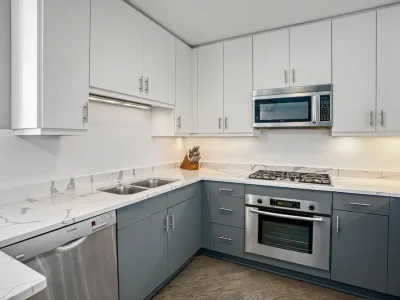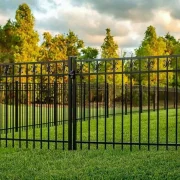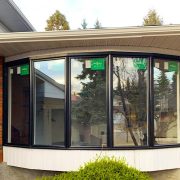Homeowners are increasingly looking for ways to secure their property without sacrificing style, and aluminum fences fit that goal with a clean, architectural presence. While traditional materials have their place, many who appreciate the craftsmanship of a Cedar Rustic Fence also want a modern profile that won’t demand constant upkeep. Aluminum Fencing brings that balance—lightweight construction paired with strength, minimal maintenance, and finishes that hold up to tough weather. In the sections below, you’ll find how aluminum excels in rust resistance, the range of design options available, and what to consider during installation. You’ll also see how this material meets contemporary design trends with streamlined lines, subdued color palettes, and a long-lifespan finish.
Rust-Resistant Construction for Long-Term Durability
One of the biggest advantages of aluminum fences is their inherent resistance to corrosion, even in humid or coastal climates. Unlike steel, aluminum naturally forms a protective oxide layer that shields it from rust, which is then amplified by factory-grade powder coating. This multilayer protection means the finish doesn’t flake or bubble easily, and the underlying metal remains structurally sound for years. Homeowners who’ve dealt with constant sanding and repainting on other materials will appreciate the low-touch upkeep and steady appearance. The result is a fence that maintains its value and looks as crisp in year five as it did on day one.
Key factors that protect against corrosion
Several elements contribute to the longevity of a well-built system. Quality powder coats cure at high temperatures, fusing pigment to the metal for a hard, colorfast shell that resists UV fade and weathering. Hardware choices matter, too—stainless steel or coated fasteners reduce galvanic reaction, and concealed connections keep water from pooling around joints. Many panels are engineered with sloped or sealed rails to prevent moisture intrusion, which prolongs the life of internal cavities. When all these details work together, the fence offers long-term durability with minimal intervention, making it a practical choice for properties in diverse climates.
Modern Architectural Designs That Complement Any Home
Aluminum’s crisp geometry naturally pairs with contemporary architecture, but it also complements transitional and even traditional exteriors. Slim pickets and narrow spacing offer security without visual heaviness, and horizontal rails can establish pleasing symmetry with window lines and porch trim. For homes with brick or stone, aluminum brings a refined contrast, highlighting textures without competing for attention. The right profile can even lighten the look of deep eaves or dark facades, making the property feel more open. If your home favors minimalist features, the streamlined forms enhance that intent rather than cluttering it.
Style pairings to elevate curb appeal
Modern row houses and mid-century properties often benefit from horizontal or flat-top designs with squared posts. Craftsman or farmhouse styles usually shine with narrow pickets and subtle finials that nod to tradition without slipping into ornate territory. For urban lots, darker finishes present a low-reflective, gallery-like boundary that frames landscaping and architectural details. In suburban settings, gently arched gates add a touch of welcome while maintaining overall restraint. By selecting profiles that echo rooflines, window grids, or railing motifs, the fence reads as part of the home’s architecture, not an afterthought.
Finish and Color Choices for Customized Style
Today’s powder coat technology offers a spectrum of colors and textures, from matte black and warm bronze to graphite and soft charcoal. Subtle sheens minimize glare and hide smudges, while micro-textured finishes disguise dust and pollen between cleanings. Choosing a finish isn’t only about color; it’s also about how light plays across the surface throughout the day. In bright sun, a matte surface reduces reflectivity, while a satin finish can lend a gentle, upscale glow. Homeowners who admire simplicity often gravitate to restrained tones that blend with window frames, garage doors, and trim.
How to choose finishes that harmonize with the exterior
Start by mapping existing accent elements—roof flashing, door hardware, light fixtures—and select a finish that complements those anchors. If the home has mixed materials, use the fence to harmonize them, bridging warm siding with cooler masonry through a neutral, balanced shade. For landscapes heavy with greenery, darker tones fade into the background and let plants take center stage. Where the architecture relies on striking geometry, a slightly lighter finish can emphasize the fence’s clean lines without overpowering the facade. Integrate gate hardware in matching or intentionally contrasting finishes for a cohesive, intentionally designed look that underscores the value of Aluminum Fencing.
Lightweight Panels That Support Easy Installation
Aluminum components are significantly lighter than comparable steel options, which makes delivery, handling, and staging more efficient. A lighter system reduces the risk of damage during transport, and installers can move panels into place with smaller crews. This has practical benefits for tight urban lots where access is limited or steep properties where maneuvering heavy materials is risky. Rackable panels, designed to adjust to grade changes, further streamline the process on sloped sites. The combination of low weight and smart engineering translates to faster installations and less disruption to your property.
Steps that simplify setup from start to finish
- Confirm property lines and layout post locations with utilities marked before digging.
- Use rackable panels to follow contours; this avoids stair-stepping and creates a polished, continuous look.
- Set posts in properly sized footings with a level and string line, checking height and spacing as you go.
- Attach panels with corrosion-resistant hardware, then hang gates last to fine-tune swing and latch alignment.
- Finish by rinsing dust and debris from the fence so the powder coat shows its intended finish right away.
With these steps, the installation stays organized and predictable, saving time whether you’re hiring a pro or coordinating a DIY project. When planning, it’s also smart to align panel widths with post placement to minimize cuts and maintain structural integrity. Gate openings should be framed with heavier posts or internal reinforcements to handle daily operation smoothly. Many homeowners appreciate that Aluminum Fencing arrives in modular sections, which reduces on-site customization and maintains consistent factory quality.
Balancing Strength and Flexibility in Aluminum Systems
A common question about aluminum is how it can be both sturdy and adaptable. The answer lies in a combination of alloy selection, wall thickness, and rail reinforcement that deliver robust performance without extra weight. Properly engineered panels resist wind deflection and everyday impacts while retaining just enough flex to avoid brittle failure. This balance is especially valuable in regions with seasonal storms or temperature swings, where rigid materials may crack or warp. By distributing stress through the rail and post system, the fence holds its form and alignment over time.
Engineering details that matter in real-world conditions
Look for rails with internal stiffeners or larger profiles at the mid-rail to reduce bowing. Tighter picket engagement improves stability, while concealed fasteners cut down on rattle and connection fatigue. Gates benefit from welded corners or gusseted frames that handle repeated use and protect latch alignment. In pool areas or high-wind zones, code-compliant spacing and heavier posts ensure safe, consistent performance. When specified thoughtfully, these details don’t add visual bulk; instead, they reinforce a clean silhouette that feels intentionally designed and built for the long haul.
Minimal Maintenance Requirements Compared to Other Materials
One of the most compelling reasons to choose aluminum is the minimal upkeep it requires. Whereas wood may call for staining and steel often needs rust treatment, aluminum typically asks for a simple wash a few times per year. The bonded powder coat wards off UV fading and surface degradation, meaning your fence won’t demand patch painting after every winter thaw. For busy homeowners, that translates to more time enjoying outdoor spaces and less time maintaining them. Budget-wise, fewer maintenance cycles can also help offset initial investment over the fence’s lifespan.
A simple care routine that preserves long-term value
Rinse the fence with a garden hose to remove dust, pollen, and salt spray, then spot-clean with a mild soap on stubborn spots. Avoid harsh abrasives that might scratch the finish, and use a soft brush or microfiber cloth for best results. A quick visual check once or twice a year for loose fasteners or gate alignment is usually sufficient. If landscaping crews work nearby, remind them to keep string trimmers and fertilizers away from posts to protect the coating. Homeowners who’ve previously relied on options from Cedar Rustic Fence often appreciate how aluminum’s low-maintenance profile complements their desire for dependable, attractive outdoor boundaries.
Why Aluminum Fencing Fits Contemporary Aesthetic Trends
Today’s design landscape favors clean lines, functional forms, and materials that age gracefully without excessive care. Aluminum meets that brief with slim profiles, subtle finishes, and a modular approach that scales from compact city lots to expansive suburban yards. As homeowners blend outdoor and indoor living, they want enclosures that frame spaces without blocking sightlines, and aluminum’s linear geometry does exactly that. The material also aligns with sustainable priorities; it’s long-lasting and recyclable, helping reduce the frequency of replacements. Together, these qualities reinforce a design language that feels both current and enduring.
Design cues shaping demand for a modern look
Current trends emphasize continuity—matching fence lines to window grids, deck railings, and even pergola elements for a unified exterior. Dark, matte finishes recede into the landscape, allowing plant textures and architectural forms to stand forward. Simple gate profiles with precise hardware feel elevated without shouting for attention. Subtle accents like post caps or minimal finials can introduce dimension while preserving a quiet, cohesive aesthetic. If you’re comparing options after exploring what a Cedar Rustic Fence might offer, note how Aluminum Fencing brings a sleek counterpart that integrates naturally with contemporary palettes, material mixes, and the streamlined look homeowners value today.














Comments